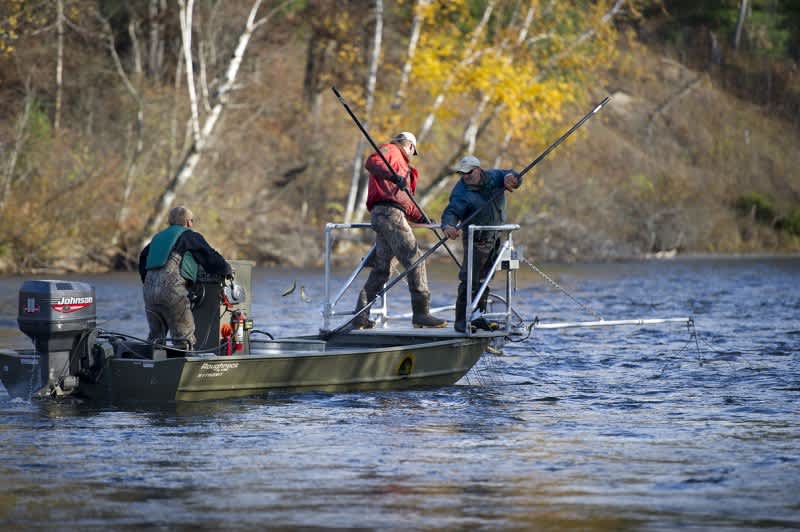Michigan’s Sturgeon River Strain Brown Trout Show Promise
OutdoorHub 11.17.11

Recent Department of Natural Resources Fisheries Division electro-fishing surveys below Hodenpyl Dam on the Manistee River and on the Au Sable River below the dam at Mio produced vastly different results, though they did have a couple of common characteristics.
Fisheries crews turned up more than 800 trout during a half-day survey with two shocking boats on the Au Sable, in a stretch that has come to be dubbed “the trophy water” because of the large trout there.
On the Manistee, two shocking crews turned up just over 100 trout.
But the crews did find some unusually large brown trout in both river stretches and they found something else they were looking for – good survival of Sturgeon River strain brown trout, something biologists hope bodes well for the future of brown trout fisheries in Michigan.
Fisheries Division, discouraged by relatively low return rates from stockings of brown trout in recent years, began stocking a different strain of browns – the Sturgeon River strain – in 2010. The Sturgeon River strain brood stock was collected from wild trout out of the Sturgeon River in the northern Lower Peninsula whereas other strains are raised from brood stock maintained in hatcheries.
Michigan had been using several other strains of brown trout for its stocking programs over the years – most notably Wild Rose and Seeforellen – but the DNR has seen relatively poor recruitment into the fishery in its Great Lakes and inland-lake stocking programs. Biologists wondered if going to a different strain would help.
Research biologist Todd Wills said Fisheries Division identified the Sturgeon River strain as a potential replacement for the Seeforellens in both the Great Lakes and inland lakes. But when fisheries biologist Steve Sendek – who works out of Grayling and is responsible for the Au Sable River – heard about the idea, he suggested that Fisheries Division stock the new strain (along with equal numbers of Wild Rose browns) in the tailwater fishery below Mio, too.
Fisheries biologist Mark Tonello, who is responsible for the Manistee River, seconded the motion. So Fisheries Division stocked both strains in the river stretches, marking them with different fin clips.
In the Manistee River, the marked brown trout collected by electro-fishing during the recent survey were all the same strain.
“We only found Sturgeon River fish,” Wills said. “We did not see any Wild Rose fish – not a one.
“The overall catch of trout was very low,” he continued. “It’s encouraging to see the Sturgeon River browns – and it leads us to believe that they did better than the Wild Rose browns – but with the catch as low as it was, it’s difficult to make any firm conclusions.”
That the catch was low was not entirely surprising as the Manistee River below Hodenpyl is marginal trout water and during the summer of 2011, the area suffered through the hottest July on record. Under those adverse conditions, a low survival rate of stocked trout is not unusual.
Although the catch was much better below Mio, the marked Sturgeon River fish recovered by the shocking crew far outnumbered the Wild Rose strain.
“There’s no question that below Mio, the Sturgeon River brown trout are doing better than the Wild Rose strain,” Sendek said. “We found about five times as many Sturgeon Rivers as Wild Roses and not just young-of-the-year fish; it looks like the Sturgeon River fish carry over from year to year better than the Wild Rose, too.”
Sendek said he is encouraged by what he’s seen so far.
“Since the Sturgeon River fish are a wild strain, they’re a little harder to work with than the Wild Rose, which is a domesticated strain,” Sendek said. “They come out of the hatchery smaller than the Wild Rose fingerlings, but they catch up.
“I’m looking for the fishery below Mio to not only keep going, but get better,” he continued. “With year-round fishing now and new regulations, this could be a win-win situation. This fishery is very special. And we can’t count on natural reproduction to sustain that fishery because of the influences of the dam. Stocking is going to be an important part of maintaining that fishery.
“I’m very optimistic about the future with the early results. I’m hoping this will revitalize all of our brown trout fisheries – we just have to learn how to utilize this new tool.”
Wills said that the Au Sable probably has better ground water resources than the Manistee and therefore would probably provide more cold-water sanctuary areas for trout during a hot summer.

“In addition to warming caused by the dam, the Hodenpyl stretch of the Manistee has a lot of clay soils and that’s not good for ground-water movement,” he said.
And although the survey results are not complete, “it appears from the data we have now that the Sturgeon River strain browns are doing better in the tailwater fisheries – the Au Sable and the Manistee – than the Wild Rose,” Wills said.
As for the lake portion of the study, it’s too soon to tell, he said.
“We are not seeing a large return from any of the marked fish in the inland lakes we’ve stocked,” Wills said. “To date we’ve seen more Wild Rose fish, so the Wild Rose strain seems to be doing better. However, some of the lakes that we stock are difficult to sample with our survey gear, so we’re working with local fisheries managers to obtain reports from anglers to supplement information we collect in the field.
“We’ve also stocked Sturgeon River and Wild Rose strain fish in Lake Michigan, but our creel clerks haven’t seen any returns so far. Brown trout returns in Lake Michigan have been pretty low in general, and these fish may still be a little smaller than those typically harvested and reported by anglers,” Wills continued.
“We’ll see what happens.”

